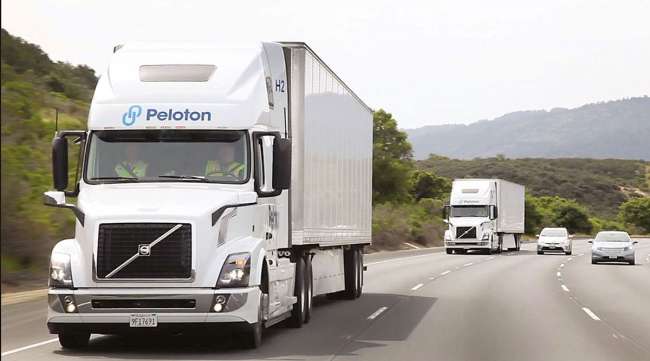Peloton Demonstrates Platoon System in Michigan

Peloton Technology recently demonstrated its driver-assist truck platooning system on Interstate 96 in Michigan with two Volvo VNL 670 trucks, featuring one following about 60 feet behind the lead truck.
The demonstration was conducted on Dec. 1 in the Novi area with the state police, the Michigan Department of Transportation, and the state’s economic development agency.
Peloton announced it plans to deploy the system commercially in 2018.
A 2016 Michigan law allowed two electronically-coordinated commercial trucks to platoon on its roads closer than the state-mandated 500-foot minimum as long as the operators submitted plans to the Michigan Department of Transportation and Michigan State Police.
“Michigan has been a national leader in the legislative approval of connected and automated vehicles, so we were excited to demonstrate the Peloton truck platooning system in the Detroit area as a stepping stone towards commercial deployment within the state,” said Steve Boyd, Peloton co-founder and VP of external affairs. “The demonstration showed key Michigan leaders the safety, efficiency and mobility benefits that this technology provides to fleets and the public. We look forward to our ongoing work with the state of Michigan and industry partners across the region as we bring driver-assistive truck platooning into commercial deployment.”
Today @PelotonTech is demonstrating driver-assistive truck platooning on I-96 in Michigan. Peloton's system automates speed and determines optimum following distance, resulting in safer conditions and fuel savings. @MichiganDOT #PlanetM #Mobility pic.twitter.com/rCKLXcC3oA — PlanetM (@planetm) December 1, 2017
“We are committed to advancing safety and efficiency in commercial trucking operations and accelerating the economic benefits that result from improving the movement of goods,” said Kirk Steudle, director of the Michigan Department of Transportation. “Many companies in Michigan’s automotive industry are playing a key role in the development of connected and automated vehicle technologies like platooning. The state is proud to be a leader in paving the way for the deployment and growth of vehicle platooning technologies which can bring great value to the region.”
Peloton’s program includes a wireless vehicle-to-vehicle communications link between two trucks that allows them to form a platooning system where one follows the other at a close distance to create a fuel-saving aerodynamic draft. The system offers in-cab audio and video display for both drivers.
At a 40- to 50-foot following distance the system can reduce fuel use by 4% for the lead truck and 10% for the following truck, for a combined 7% reduction, according to the North American Council for Freight Efficiency. The council notes that savings could be 4% under real world conditions. The National Renewable Energy Laboratory has pegged team fuels savings at 6.4%.
Mountain View, Calif.-based Peloton operates a cloud-based Network Operations Center that can pair up trucks and can adjust system parameters for local conditions. Peloton requires each truck be equipped with such safety features as collision avoidance, always-on radar sensors, lane departure warning and air disc brakes.

